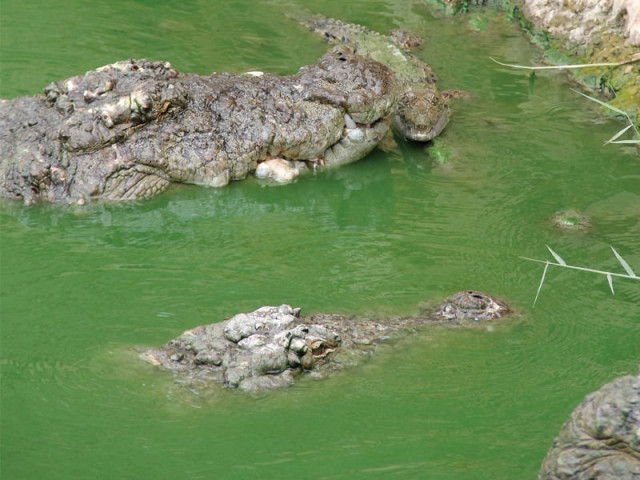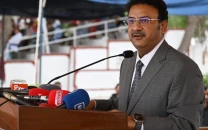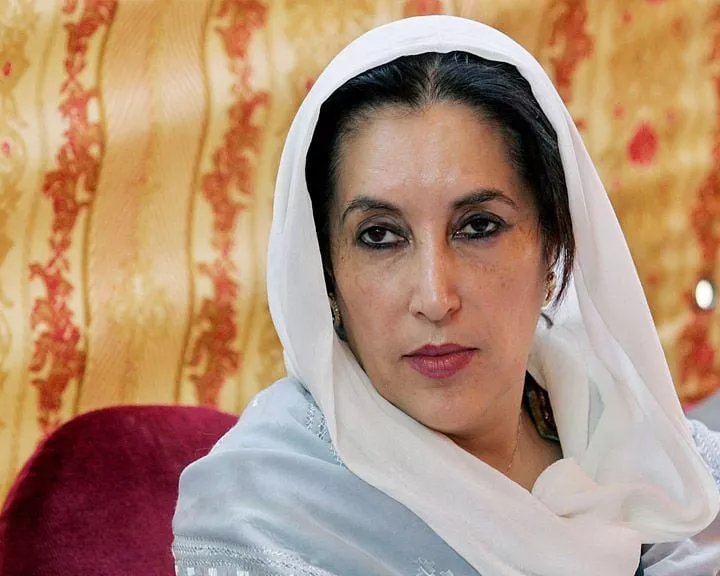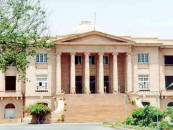With Pir Mangho watching over, NA-243 prays for peaceful elections
The constituency covers Manghopir Shrine, marble factories and Hub Dam .

The Sheedi community believes that the crocodiles at the Manghopir Shrine will not harm the devotees. PHOTO: AYESHA MIR/EXPRESS
As devotees of Baba Manghopir bathe in the holy water, they offer a unanimous prayer to ward off all evils that could harm their loved ones during the upcoming elections which they believe will spark the worst blood bath the residents have ever seen.
Manghopir, which comes under the constituency NA-243, was once home to Sufi Pir Mangho Haji Syed Sakhi Sultan and the crocodiles at his shrine, which residents believe were gifted to Pir Mangho by Baba Farid. But over the years, the area has also become a stronghold of the Tehreek-e-Taliban Pakistan who have reportedly established their seminaries around the shrine. Thus, the area which was known for its Pir Mango Urs at one of the oldest shrines in Karachi now boasts of recurring incidents of extortion, target killings and bomb blasts.
Apart from the sensitive law and order situation due to the presence of terrorists, one of the biggest problems in the constituency is of land grabbing. The area, which has been deprived of real development for decades, also faces problems of clean water, sewerage and street crime, including murders and snatchings.
Around 135 different small goth (villages) – including Khamiso Goth, Ibrahim Goth, Yousuf Goth, Mai Gari and Mengal Goth – and Surjani Town fall under this constituency and are populated by a large number of Baloch and Sindhi. NA 243 also covers some sectors of North Karachi, parts of Khamiso Goth, Rajput Colony and sectors of Mustafa Colony.
Constituency & Candidates
Area: 50 square km
Constituent areas
North Karachi’s Sectors 1, 2 and 3, 5A-1, 2 and 3, 5A-4, 5B-1, 2, 3 and 4, 5D, 5M, 5F (partly), 6 C and D, Khamiso Goth (partly), Rajput Colony’s Sectors 5J (partly), 5E (partly), 5L, Mustafa Colony, and the katchi abadi adjacent to Sector 5B, Sector 5G (partly), commercial area near the graveyard and Sectors 12, 6A and B, Ajmer Nagar, Manghopir, Surjani, Surjani Town, Ibrahim Goth, Yousuf Goth, , Mai Gari and Mengal Goth


Results - NA
2008
NA-243 (Karachi)
Abdul Waseem – 167,764
Zafar Ahmed Siddiqui – 22,147
2002
NA-258 (Karachi)
Sultan Ahmed Khan – 62,245
Muhammad Saleemuddin Qureshi – 13,105
Results - PS
2008
PS-97 (Karachi)
Muhammad Adil Khan – 54,603
Baboo Abdul Khalique Mirza – 27,221
2002
PS-97 (Karachi)
Muhammad Hussain Khan – 17,872
Baboo Abdul Khalique Mirza – 10,920
2008
PS-98 (Karachi)
Muahmmad Moin Khan – 95,168
Dr Muhammad nasir Khan – 3,711
2002
PS-128 (Karachi)
Syed Sardar Ahmed – 34,118
Mohammad Jameel – 8,189
2008
PS-99 (Karachi)
Khawaja Izharul Hassan – 76,8803
Sohail Sami Dehlvi – 3,503
2002
PS-129 (Karachi)
Qamar Mansoor – 30,324
Nasir Rizwan Khan – 4,864
Sheedi Mela
Manghopir is also home to the African-descended community, often referred to as Makranis or Sheedis, who hold the spiritual and cultural festival, Sheedi Mela, every year at the Manghopir Shrine. Known for the African-influenced rituals of the Sheedi community, the mela attracts people from all over Sindh, Balochistan and Punjab.
During a ceremony, a garland is put around the neck of the chief of the crocodiles, referred to as Mor Sahib. The Sheedis believe that the crocodiles at the shrine will not harm any devotee.
The people, the places
Pakistan’s third largest dam, Hub Dam, which is one of the main supplier of drinking water to the city falls under this constituency. The dam has been extended to 24,300 acres with the gross storage capacity of 857,000 acre feet. But despite the dam’s presence, the areas in NA-243 lack proper water supply while sewerage overflows in the streets, said a resident of Sindhi Hotel. “We don’t see any silver lining to these elections,” he said.
Most of the residents of the constituency are factory workers, labourers, pushcart vendors, bus drivers, and motorcycle mechanics. The marble factories near the Manghopir Pehari are among one of the most thriving businesses in the area. More than 350 medium and large-sized factories in Manghopir annually process around 400,000 tonnes of marble brought to the city from the mountainous areas of Balochistan.
The residences in the constituency mostly include low grade apartments and katchi abadis.
Among the constituency’s distinctive features are its youngsters. They are known to be habitual of mava, gutka, betel leaf and low grade cigarettes. Hashish and homemade liquor is also commonly used, especially in the slum areas of the constituency.
Motorcycles decorated by shiny and colourful belts with designed number plates are a unique trait of the residents of Sindhi Hotel.
Down Memory Lane
“Every election, we are promised change for the better but things remain the same as they were 20 years back,” said 60-year-old Lala Humayun Khan, a resident of Manghopir.
In his opinion, the youth of the area were divided into sympathisers of the Taliban and the hard line activists of PPP, ANP and MQM. “The problem in this area is that people are not politically aware.”
Recalling previous elections, Khan said that the political scenario was not as bad as today. “Today, the Taliban have established their writ in the area, the general public are least concerned about the outcome of the elections and voters have become mere spectators.”
Published in The Express Tribune, May 3rd, 2013.



















COMMENTS
Comments are moderated and generally will be posted if they are on-topic and not abusive.
For more information, please see our Comments FAQ